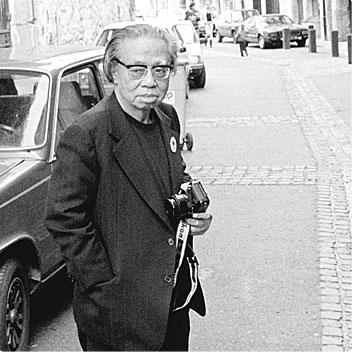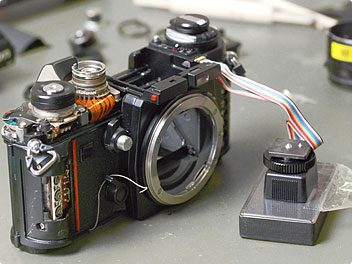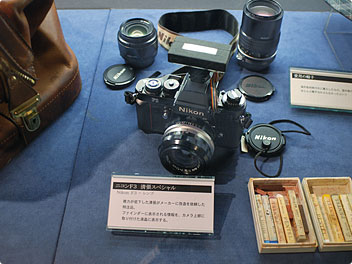
Seicho Matsumoto visiting Grenoble, France in 1987 to attend "Festival International du Roman et du Film Noir." In his hand is a Nikon F-501 that is also on display at the Matsumoto Seicho Memorial Museum.
Seicho Matsumoto was a nationally renowned Japanese writer who broke new ground with the genre of "social mystery," addressing a wide range of topics in the course of his career. He began writing at the age of 42 and went on to author over 1,000 works—ranging from short stories to full-length novels—in a career that spanned over 40 years. These included bestsellers such as Points and Lines, Walls of Eyes and Inspector Imanishi Investigates. The author is also well known for featuring a photographer as the protagonist in some of his stories and for including topics relating to photography.
The following description of the F3HP Seicho Matsumoto Special single-lens reflex camera (hereafter called the "F3 Seicho Special," as the author was commonly known in Japan by his first name only), a camera which was specially modified for Matsumoto, includes comments by Nikon Fellow Tetsuro Goto. The F3 Seicho Special is on permanent display at the Matsumoto Seicho Memorial Museum in Kitakyushu, Fukuoka Prefecture.
A special request to Nikon

The Nikon F3 was a single-lens reflex film camera released in 1980 by Nikon (formerly Nippon Kogaku K.K.). Nikon's flagship model of the day, it was the first Nikon camera to utilize electronic control, and was equipped with state-of-the-art electronics technology. An example of this was the liquid-crystal display (LCD), which showed information, such as shutter speed, that on earlier cameras had been displayed by means of an indicator or a simple LED. This was now visible as a numerical reading on an LCD panel inside the viewfinder.
The LCD is designed to be easily visible for users with normal eyesight. However, Matsumoto could not see it very easily, as he was extremely near-sighted.
Matsumoto also left behind photographs that he had used as resource materials for his written work. Given the intricacy of his work, it is safe to assume that he wanted the most precise information when using the camera. As a result, he asked Nikon to make the LCD display easier to read.
The designer's response

Tetsuro Goto
Joined Nippon Kogaku K.K. (now Nikon) in 1973. In 1975 he was assigned to the Camera Designing Department where he worked on electrical circuitry design for the F3. He then served as chief of electronic systems for the F4 and product chief for the F5. Subsequently he directed work on digital single-lens reflex cameras up until the D3 Series and on interchangeable lenses, among other projects. In 2004 he was made an operating officer of the company. Appointed a Nikon Fellow in 2009, he then launched the Imaging Product R & D Laboratory.
It fell to Tetsuro Goto, who was in charge of the electronic design of the F3 and worked in Nikon's Camera Designing Department, to respond to Matsumoto's request.
"I learned of Matsumoto's request in 1984 and took delivery of his F3. I came up with the idea of enlarging the LCD panel and mounting it on the camera externally in order to make the LCD easier to see. I thought I could probably make use of LCD panels that were fitted on commercially available digital watches. I ordered various samples, but of course the segments on the LCDs used on digital watches did not match up with the segments of the LCD inside the F3's viewfinder. After agonizing over the problem, I discovered by chance that if I turned the digital watch LCD upside down, its segments closely matched the segments on the F3's display. I was so delighted that I couldn't stop congratulating myself. However, since there were no '+' or '-' marks on the digital watch LCD to indicate over- or under-exposure, these were indicated by 'AM' and 'PM' symbols instead," recalls Mr. Goto excitedly.

Comparison of the LCD panel inside the viewfinder and the externally mounted LCD panel when the shutter speed is 1/250 second, the exposure mode is manual and the exposure value is correct. On the externally mounted LCD panel, the indicators 'M', '+' and '-' have been substituted with the alarm indicator and the 'PM' and 'AM' symbols. The white square is to conceal superfluous data.
Painstaking customization
Once Mr. Goto saw that externally mounting the LCD panel worked, he decided to continue with the modifications. First, the F3's electronic circuit board had to be connected to the digital watch LCD panel using a multicore cable. With as many as 30 pins on the F3's electronic circuit board, the pin pitch was very tight. Mr. Goto soldered the pins by hand while viewing them through a magnifying glass. A further complication was that ordinary solder would not adhere to the pins on the digital watch LCD panel. As a result, special solder that contained silver was ordered.
Once the soldering was complete, a hole was made in the camera body for the multicore cable to pass through. This task was given to a mechanics designer familiar with the construction of the F3. Whenever a hole is made in the body of a camera, there is the danger of light leaking into the body and exposing the film. To prevent light leaks, the cable was made as thin as possible, the hole was kept as small as possible, and the tiny gaps between were plugged with black putty made of silicon.
"Both the soldering work and the filling with putty represented craftsmanship that required dextrous fingers," says Mr. Goto.
The pentaprism unit on the standard F3 was not fitted with a hot shoe. However, Matsumoto's F3 had a hot shoe attached, a modification that was designed for journalists.


Images taken when camera was inspected and adjusted
After the digital watch LCD panel had been wired up, Mr. Goto encased it in a transparent box. He then masked the perimeter of the box with black tape so that only the LCD was visible. In addition, the foot of a Speedlight was affixed to the back of this box, so that a Speedlight could be attached to the hot shoe. With all the work completed, the uniquely designed F3 Seicho Special came into being, characterized by the small box mounted on the pentaprism unit. Matsumoto's request had been fulfilled and exposure information could now be read off the large digital watch LCD with ease.
The F3 Seicho Special—with functions specified in advances
In the manufacture of its cameras, Nikon has always put a premium on durability and reliability. The company was thus cautious about mounting external LCD panels on single-lens reflex cameras. The first camera on which an external LCD was adopted was the F-801 (N8008), which was released in 1988. In this context, the F3 Seicho Special can be regarded as a revolutionary design, since it was equipped with an external LCD some four years ahead of commercial models.
"A variety of special-purpose cameras were manufactured during the film camera era. One of these was the F3 Seicho Special. Since these cameras all had their own unique specifications, however, once there was no longer a use for them, most were put aside and ended up being lost. Because the F3 Seicho Special is seen as a reflection of Matsumoto's character, it has been carefully preserved and is now on display. Having been in charge of the development of this camera, I am extremely grateful for this. Maintenance of the camera in November 2009 restored it to perfect condition," explains Mr. Goto.

"S. MATSUMOTO" is engraved on the camera back. Because Matsumoto used photos as resource materials for his written work, an MF-14 data back was attached in order to record the date and time on the film.

The Nikon F3 Seicho Matsumoto Special is displayed alongside other items that Matsumoto commonly used.
Compiled with the cooperation of the Matsumoto Seicho Memorial Museum, run by the city of Kitakyushu

